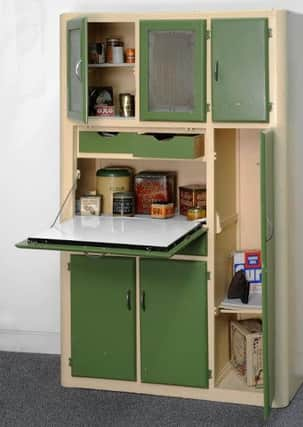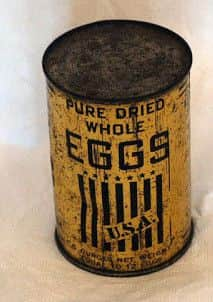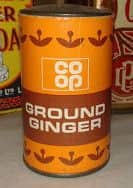Leeds nostalgia: Kitchen of Curiosities at Leeds Discovery Centre


Cabinet of Curiosities
The wooden space-saving kitchen cabinet dates from the mid-20th century and incorporates a fold down enamel worktop, ironing board and a series of green painted cupboards and drawers to store cutlery, table linen, tableware and food.
It sits at the far end of the main corridor in the Discovery Centre, just slightly beyond the store entrance. To find it you must postpone entering the store or remember to double back before you leave.


Advertisement
Hide AdAdvertisement
Hide AdThere is a collection of food packaging from our social history collection within it.
The first is a small cylindrical gold tin containing 12 pure dried whole eggs in powdered form, supplied by the United States, and issued by the Ministry of Food for distribution in Great Britain as a response to a wartime shortage of fresh eggs, c.1940-50.
Users were instructed to store them away from anything with a strong smell and when required, to mix one level tablespoon of dried egg with two tablespoons of water making sure to “work out lumps with a spoon against the side of the bowl”.
The egg had to be used immediately after mixing and was most suitable for scrambled eggs or omelettes. Uptake of the dried eggs was slow and the Ministry of Food issued posters to promote their use.


Advertisement
Hide AdAdvertisement
Hide AdThe second is a jar of Co-op Ground Ginger. Dating from the late 1960s, this small jar of ground ginger features the distinctive ‘cloverleaf’ Co-op logo on the side. In 1968 The Co-operative Working Society (CWS) worked with the co-operative societies around Britain to rebrand under a single Co-op logo in a move to unify branding across all the retail shops. Stores that wished to use the new logo had to undergo refurbishment.
In 2016 The Co-operative Group announced that it would return to a refreshed blue version of the cloverleaf logo. The third object is a Potter’s Asthma Remedy.
Potters’ inhalation products were well known and widely used throughout the early to mid 20th Century.
Users were instructed to inhale a heated teaspoonful of the powdered herbal remedy on a daily basis. This product continued to be manufactured until 1988 when the UK’s Department of Health refused to renew the product licence. Recent research has shown that the products may in fact have posed similar health risks to smoking.


Advertisement
Hide AdAdvertisement
Hide AdPamela Crowe, volunteer tour guide at Leeds Discovery Centre, said: “In April 2015 I gave my first tour of the Discovery Centre. I recall spending too long talking about this 1950s kitchen cabinet. It still draws me, I think of it as a Kitchen Cabinet of Curiosities.
“It’s not a huge leap to view the entire Discovery Centre as a vast cabinet of curiosities. Our collections comprise both the familiar and unfamiliar: from the bones of a dodo or 4.5bn year old iron meterorite to a washing machine from Grandma’s house or tin of egg powder.”
Words by Pamela Crowe, volunteer tour guide and blogger, Leeds Discovery Centre